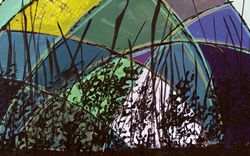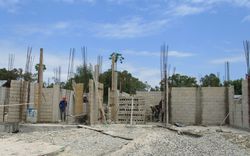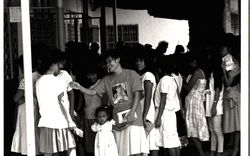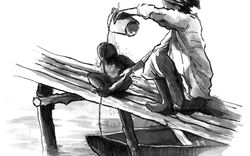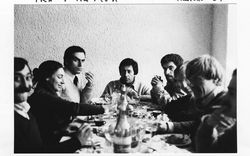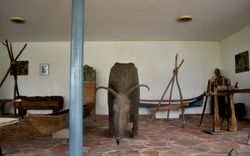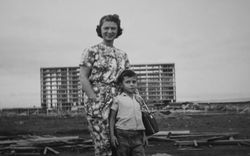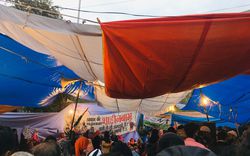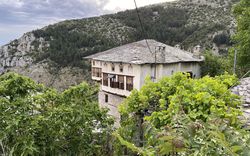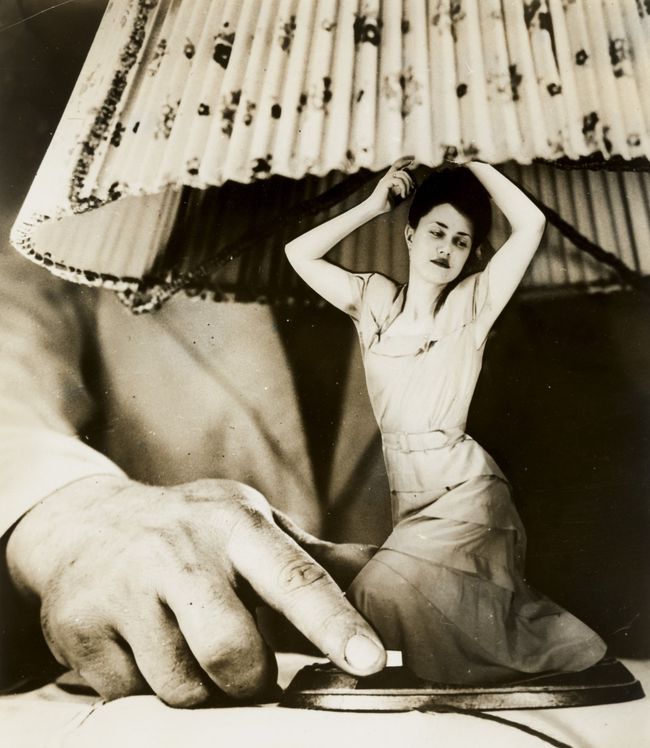On Diffractions: Feminist Architectural Histories of Migration
Anooradha Iyer Siddiqi and Rachel Lee introduce our latest issue
In this collection, we examine people, places, and things as diffracted through migration. Migration is an event and a concept. Diffraction is what happens in the moment when energy meets an obstacle. The feminist histories collected here speak of that moment.
Of Migration is the second installment of “Feminist Architectural Histories of Migration,” a multi-sited collection of works that takes migration as its core concept and historical event to better understand feminist thought, work, and narrative in a spatial, material, and aesthetic field. This investigation takes place in three open access platforms: Architecture Beyond Europe, the CCA website, and Aggregate. Siting the collection within a three-platform scaffold, even if situated in an epistemic North, gestures to the conceptual instabilities of migration.
Such instabilities appear in a photomontage by a migrant artist exiled in Argentina, which points to coerced domesticities and femininities as well as the resistance to them. They emerge in a painting by an East African artist of an architecture of migration, inextricable from associations with the life of the refugee, yet recuperated as a critical symbol of heritage.
Grete Stern, Sueño Numero 1: Articulos eléctricos par el hogar [Dream No. 1: Electrical Appliances for the Home], photomontage, 1949. From the Sueños [Dreams] series. Courtesy of Museum of Modern Art. © 2021 Galería Jorge Mara-La Ruche
In these two images, we return to premises that have animated this collection: “that the dynamic of a situated and re-situated perspective is foundational to feminist histories of architecture,” and “that feminist historiographical approaches destabilize presumptions of fixity that have driven the writing of architectural histories.”1 The works collected here explore architectural histories through feminist practices of knowledge creation. They investigate the potential of writing architectural narratives from a situated perspective while foregrounding subject-objects in motion. This spectrum includes four means of investigating and knowing migration, categories that roughly correspond to and organize the articles to follow. These are representation, materiality, space, and memory.
The first involves observing, recording, and analyzing space through in situ drawing. Handcrafting images of places created by migrant communities acknowledges them without fixing or enumerating them, and instead attends to them through focus and facture. Drawing creates space for social interaction, for quiet commune with a place and its makers. Around and through drawing, conversations occur that expand the understanding of spaces reproduced in pencil or ink on paper. In the articles in this collection, drawings provide grounding to more extensive analyses of Somali malls in Cape Town, South Africa, of the Ijọ fishing community in Nigeria and Cameroon, and of the construction of a house in Leyogàn, Haiti. Picturing the layout and arrangement of commercial spaces that counter marginalization, the transitional domestic riverbank space between work and leisure, and the floor plan of a house that negotiates toward a creole architecture, diffracts migrant spaces for consideration.
The second means of investigation involves affective objects as unconventional instruments of design. As architectural images and representations cross borders and meet with disparate environments, their meanings are interpreted locally. Material registers shift, while spatial sequences are reconfigured around local technologies and dwelling modes. The role of domestic objects in the creation of architecture and social space is explored in this collection through a dining table designed to foster generative exchange and grow communities through sharing meals, establishing an important node of togethering in mobile and changing networks in Ticino, Switzerland. It is also visited in shifting relationships to anonymously produced art objects in Brazil, revealing the complexities of individual identity and agency, and the challenges of non-essentializing readings of a migrant’s biography.
The third frame asks, what are the wider spaces made by migratory practices? The intersections of United States military mobility and local sex work economies in the Philippine cities of Olongapo and Angeles yield four spatial typologies—the strip, the bar, the casa, and the clinic—manifesting the inscription of these intersections into the built environment, and the marshalling of women’s bodies in extra-regulatory zones. Women’s labour made new capital cities such as Brasília, a history collected in the stories of fifty women migrants involved in the construction project. The anecdotal and conversational oral histories of this labour recuperate women’s contributions to the capital city without aggrandizing them. And in another capital, Delhi, a similar multiplicity of meanings appears central to a space of protest led by mothers, grandmothers, women, and girls, which concretizes an ephemeral sensorium of ideas, expectations, and demands.
The fourth perspective adds to drawings, objects, and spaces those intangible architectures of memory and memorialization. Heritage acts in the form of diary and eulogy seek to pause a trajectory in motion, to see the path it has taken. These entries witness the silence of footsteps and street birds in the wake of a virus, as well as the spatial embodiments and ghosts of transcontinental migrations, arrested in place, and inhabited by refugees, tourists, and an architects’ collective.
These diffractions—or more precisely, these narratives of a moment of diffraction—churn and return, revisiting time and timeframes. They loosen sediments, and surface fresh entanglements, opening the past to arrays of new presents and futures. Situated but unfixed, the movement inherent to their making and remaking as they expand and contract interweaves chronologies and shapes dynamic grounds for fluid interpretation. The intra-activity of connected timeframes, across territories through which architectures are negotiated, is itself migrant.
-
Anooradha Iyer Siddiqi and Rachel Lee, “On Margins: Feminist Architectural Histories of Migration,” Architecture Beyond Europe 16 (2019). ↩
Of Migration includes the following works, to be published on a rolling basis. Embracing the differentiation and multiplicity innate to diffraction, the authors have recorded readings of their works. We hope the aural content offers additional openings to engage with the thoughts presented here.
Architectures of care
Huda Tayob
Bathing on the canoe jetty
Warebi Gabriel Brisibe
Tracing a plan in Kreyòl
Irene Brisson
Convivium: Flora Ruchat-Roncati’s practice
Irina Davidovici and Katrin Albrecht
Lina Bo Bardi as migrant: from collector to cohabitant
Ana María Léon
Foreign arms and the economic body
Will Davis
Many stories to tell: women in the construction of Brasília
Tânia Fontenele Mourao
Dust and Lipstick [Film]
Tânia Fontenele Mourao
If on a winter’s night, azadi…
Sarover Zaidi and Samprati Pani
Originally published in Chiraghdilli, February 15, 2020
Corona diaries
Samprati Pani
Originally published in Chiraghdilli, April 6, 2020
Migration, Briefly Arrested: Revisiting Atelier 66
Claire Zimmerman
Anooradha Iyer Siddiqi is an assistant professor at Barnard College, Columbia University. Her book Architecture of Migration: The Dadaab Refugee Camps and Humanitarian Settlement (forthcoming from Duke University Press) analyzes the history, spatial politics, visual rhetoric, and iconographies of the Dadaab refugee camps in Northeastern Kenya, as an epistemological vantage point in African and Islamic worlds. Her book manuscript Minnette de Silva and a Modern Architecture of the Past engages the intellectual and heritage work of an important cultural figure in the history of Ceylon/Sri Lanka, one of the first women in the world to establish a professional architectural practice. Siddiqi directs the Columbia University Center for the Study of Social Difference working group, Insurgent Domesticities.
Rachel Lee is an assistant professor at the TU Delft’s History of Architecture and Urban Planning Chair, and an associated researcher with METROMOD, LMU Munich. Her research explores the histories of colonial and postcolonial architecture and urbanism at their intersections with migration and exile, transnational practice, heritage, mobility, and gender, particularly in South Asia and East Africa. She is currently also a Mellon Fellow with our Centring Africa project. The collection draws on ongoing research from the European Research Council funded project Relocating Modernism. Global Metropolises, Modern Art and Exile (Metromod).
